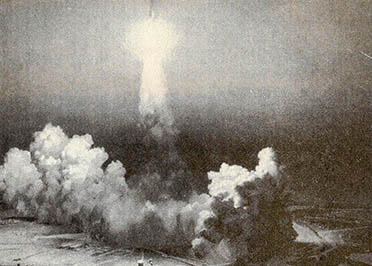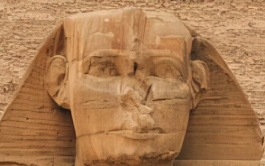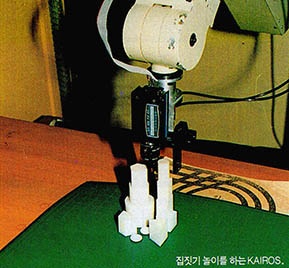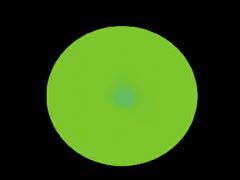
먼지는 대단히 높은 곳에서도 발견될 수 있다. 먼지폭풍은 지구 뿐만이 아니라 화성도 휘젓는다. 인간은 그들의 발자국을 달의 먼지투성이인 표면에 남겼다. 그러나 중요한 것은 지구 대기의 상부에 있는 먼지다. 대기의 여러 층중에서 가장 안정된 층은 성층권인데 이는 지구 위 10㎞에서 시작하여 50㎞에까지 걸쳐 있다. 성층권 오존층의 위험한 구멍이 커지고 있는 것은 주로 사람의 생활, 먼지폭풍, 화산활동에 의해서 보내진 먼지와 염화불화탄소의 결합 때문이다. 뉴멕시코대학의 지질학자 프란스 리트메이저의 설명에 의하면 활화산, 항공우주 활동, 그리고 외부 우주공간으로부터 나온 먼지가 성층권으로 들어간다고 한다. 과학자들은 기구, 항공기, 우주선을 사용하여 10여년동안 성층권의 먼지를 채취하여 분석하여 왔다.
화산분출(지난 10년 동안 일어난 것중 주요한 5개)로부터 생긴 먼지는 성층권에 수년간 머물려 있다. 이 먼지는 일반적으로 황화합물을 함유하고 있는데 그 양이 충분할 때에는 오존층을 손상시키고 태양빛을 가려서, 지구의 온도를 내린다. 지구에는 지금도 5백50개의 활화산이 알려져 있으며 그중 대략 12개는 어느 때든지 폭발할 가능성이 있다.
항공우주 활동도 오존층의 피해를 증가시킨다. 그 하나로서 모든 로켓은 배기 먼지를 만들어낸다. 이는 우주선이 지구로부터 발사될 때 뿐만이 아니라 운반선이 궤도위치를 유지시키려고 로켓을 점화할 때에도 발생한다. 그렇게 분출된 물질은 성층권으로 점점 내려온다.
우주발사대는 성층권에 또 다른 식으로 먼지를 만든다. 우리가 우주공간에 둔 어떤 물건도 자신이 가진 티끌들, 운석과의 충돌, 혹은 이미 그곳에 있었던 먼지들이 표면을 깎음으로서 파편을 만들어낸다.
세번째로 주요한 성층권 먼지의 출처는 우리 대기 밖의 모든 우주공간이다. 이 '우주먼지'는 어느 정도 일정량으로 유지되는데, 그것은 외부로부터 성층권으로 들어오는 먼지의 기류가 지구로 떨어져버린 먼지를 대처하기 때문이다.
리트메이저에 의하면 태양계의 초기시절부터 떠다닌 아주 작은 운석과 혜성의 파편 형태로만도 해마다 1만t씩의 우주먼지가 떨어진다고 한다. 나머지 우주먼지 입자는 태양과 다른 항성들 사이의 공간으로부터 올 수도 있다.
우주먼지에 관하여 대답할 수 없는 많은 질문이 있는 것은 우주먼지가 지구에게 지금 또는 과거로부터 미친 영향에 대히여 우리가 확실히 모르고 있기 때문이다. 과학자들은 혜성을 포함하여 그들이 발견할 수 있는 먼지의 모든 출처에 대하여 연구하고 있다.
요전번 핼리혜성의 출현은 상공의 광공해와 혜성 자체의 질량감소로 인하여 보기에 쉽지 않았기 때문에 대중을 흥분시키지는 못했다. 그러나 핼리혜성으로부터 얻어진 과학적 자료는 아직 분석되고 있는 중이다.
최근 모스크바에 있는 우주탐색연구소와 샌디에고에 있는 캘리포니아대학의 화학과, 그리고 캘리포니아 우주연구소에 있는 과학자들이 1986년에 혜성 가까이 날아갔던 베가1, 2호로부터 얻은 자료의 분석결과에 대하여 보고하였다. 우주선 밖에 설치된 질량분광 광도계에 의하면 핼리혜성의 먼지 입자에는 원시 태양성운의 응축으로 인해서 태양계가 처음 형성된 시점까지 거슬러 올라갈 수 있는 다양한 규산염의 혼합물이 있다고 한다. 그러나 그 먼지중 일부는 나머지 먼지들과 기원이 다르다고 여겨진다. 모든 혜성들은 아직 우리가 충분히 탐구하지 못한 복잡한 역사를 가지고 있을 수도 있다.
태양계 너머에 있는 먼지가 천문학자들을 성가시게 하는 것은 은하수에 포함된 먼지구름이 광학망원경의 시계를 희미하게 만들기 때문이다. 그러나 전파망원경은 그 먼지를 통과할 수 있다.
먼지는 도움이 되기도 한다. 항성이 먼지구름을 밝힐 때에는 항성으로 형성되어 버린 그 물질을 연구하기가 더 쉬워진다. 더구나 가장 최근에 일어난 초신성의 폭발로 인해(대마젤란성운에서)생긴 빛이 먼지구름을 통과해 먼지구름은 더욱 분명히 보이게 되었고, 그들 간의 거리계산도 더욱 쉬워졌다. 우리은하는 대마젤란성운보다 더 많은 먼지를 가지고 있지만 우리와 그 공간사이에는 먼지가 거의 없다.
항성들의 주위에 있는 먼지테가 가진 정보는 태양계가 그러한 테로부터 생성되었다는 과학 가설을 확인시켜 주는 것 같다. 먼지는 충분하게 주어진다면 우주를 '닫을' 수도 있는 보이지 않는 암흑물질의 일부를 형성한다.
많은 인류신화와 같이 현재의 과학 가설에 의하면 생명 그것도 먼지에서 시작되었을 것이라고 한다. 뉴욕 이타카에 있는 코넬대학 행성연구소의 칼 세이건과 크리스토퍼 치바는 생명은 새롭게 형성된 내부 태양계의 마지막 폭발 때 시작되었다는 가설을 제시했다.
행성의 형성 뒤에 남겨진 물질과 그의 위성들은 분명히 그 행성과 위성들을 향해서 돌진하였을 것이다. 우리의 달은 아직 그 결과로서 분화구를 가지고 있지만, 지구에서는 기상과 움직이는 지각판들이 그 흔적의 대부분을 지워버렸다.
최초에는 분명 먼지 가득한 대기로 지구가 둘러 싸여져 있었기 때문에 생명현상은 억제되었겠지만 바로 그 먼지를 통해서 유기화합물(생명체가 아닌)은 지구로 전달되었다. 생명체는 바로 그러한 유기화합물에서부터 진화하였는지도 모른다.
그리고 다시 그곳으로 돌아간다. 먼지에서 먼지로…
Dust can be found very high up. Dust storms stir up Mars as well as Earth. Humans have left their footprints behind on the dusty surface of the moon. But perhaps most important is the dust high in Earth's atmosphere.
Of the several layers of our atmosphere, the most stable is the stratosphere, extending from about 10 to 50 kilometers above Earth. The dangerous hole in the stratosphere's ozone layer is increasing, mostly by chlorofluorocarbons combining with dust sent up by human activity, dust storms and volcanic activity.
Geologist Frans Rietmeijer, of the University of New Mexico, explains that dust enters the stratosphere from active volcanoes, aerospace activities and outer space. With balloons, aircraft and spacecraft, scientists have been collecting and analyzing stratospheric dust for decades.
The dust from volcanic eruptions (five major ones in the last 10 years) stays in the stratosphere for several years. This dust usually contains sulfur compounds which in sufficient quantity will damage the ozone layer and block sunlight, decreasing Earth's temperature. On Earth right now there are 550 known active volcanoes, of which approximately 12 may be erupting at any moment.
Aerospace activities increase the damage to the ozone layer. For one thing, all rockets produce exhaust dust. This happens not only when a spacecraft is sent up from Earth, but when the vehicle fires its rockets to maintain orbital position. The exhaust material descends into the stratosphere.
Space launches create dust in the stratosphere in another way. Anything we put into space has fragments of its surface chipped off by our own debris, by colliding meteorites, or by the dust that's already there.
The third major source of stratospheric dust is all the rest of space outside our own atmosphere. This "cosmic dust" is present in a more or less constant amount, since what falls down to Earth's surface is replaced by the stream of dust coming into the stratosphere from outside.
Rietmeijer says that 10,000 tons of cosmic dust come in annually-as debris from comets and as tiny meteorites that may have been around since the earliest days of our solar system. Other cosmic dust particles may have come in from the space between our sun and other stars.
The many unanswered questions about cosmic dust include the fact that we don't know for certain its affect on Earth now, or in the past. Scientists study every source of it they can find, including comets.
Comet Halley's last appearance did not excite the public because it was not easy to see this time, thanks to the light pollution in Earth's skies and to its own loss of mass. But the scientific findings from Halley are still being analyzed.
From the Space Research Institute in Moscow, and from the University of California San Diego's Department of Chemistry and California Space Institute, scientists recently reported on the analysis of data from the Vega 1 and 2 spacecraft, which flew near the comet in 1986.
Mass spectrophotometers aboard the spacecraft showed that most of Halley's dust particles were found to be various silicate mixtures that probably date from the time the solar system was first being formed by condensation from the original solar nebula. Some of the dust is, however, thought to be of a different origin from the rest. It may be that all comets have a complicated history we have yet to explore fully.
Dust beyond our solar system can annoy astronomers, since dust clouds in the Milky Way galaxy obscure the view of optical telescopes. But radar telescopes get past the dust.
Dust also helps. When stars light up a dust cloud, it's easier to study the matter from which stars are being formed. Furthermore, the latest supernova explosion (in the Large Magellanic Cloud) made dust clouds more visible as its light passed through them, and made it easier to calculate their distances. There's more dust in our own galaxy than the Large Magellanic Cloud, with little dust in the space between us.
The news of dust rings around other stars seems to confirm the scientific hypothesis that solar systems form from such rings. Dust may also form part of the invisible dark matter that, given enough of it, can "close" the universe.
Like many human myths, a current scientific hypothesis postulates that life itself may have started in dust. Christopher Chyba and Carl Sagan, at Cornell University's Laboratory for Planetary Studies in Ithaca, N. Y., hypothesize that life may have begun during the last bombardments of the newly formed inner solar system.
Material left over from the formation of planets and their satellites must have hurtled down on those planets and satellites. Our moon still shows the resulting craters, but Earth's weather and shifting tectonic plates have wiped out most of the evidence here.
At first Earth must have been surrounded by such a dust-laden atmosphere that life was inhibited, but organic compounds (not life) had been delivered to Earth in that dust. It is from those organic compounds that life may have evolved.
And to which it returns. Dust to dust···
(C)1993, Los Angles Times Syndicate

















